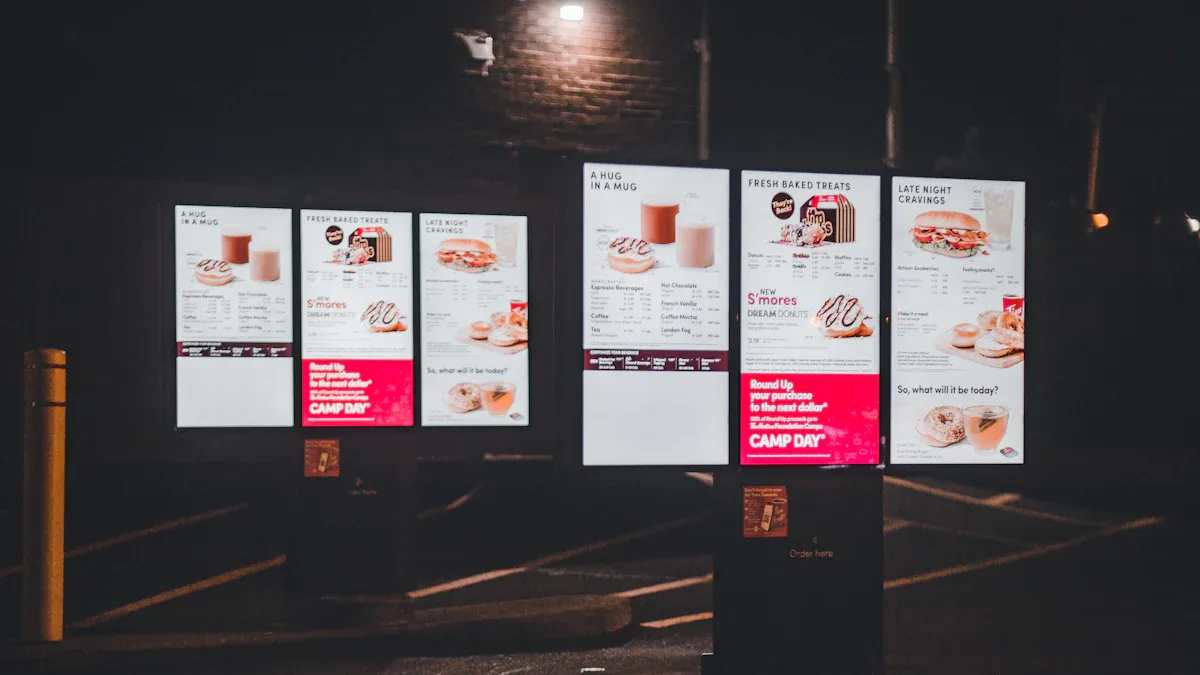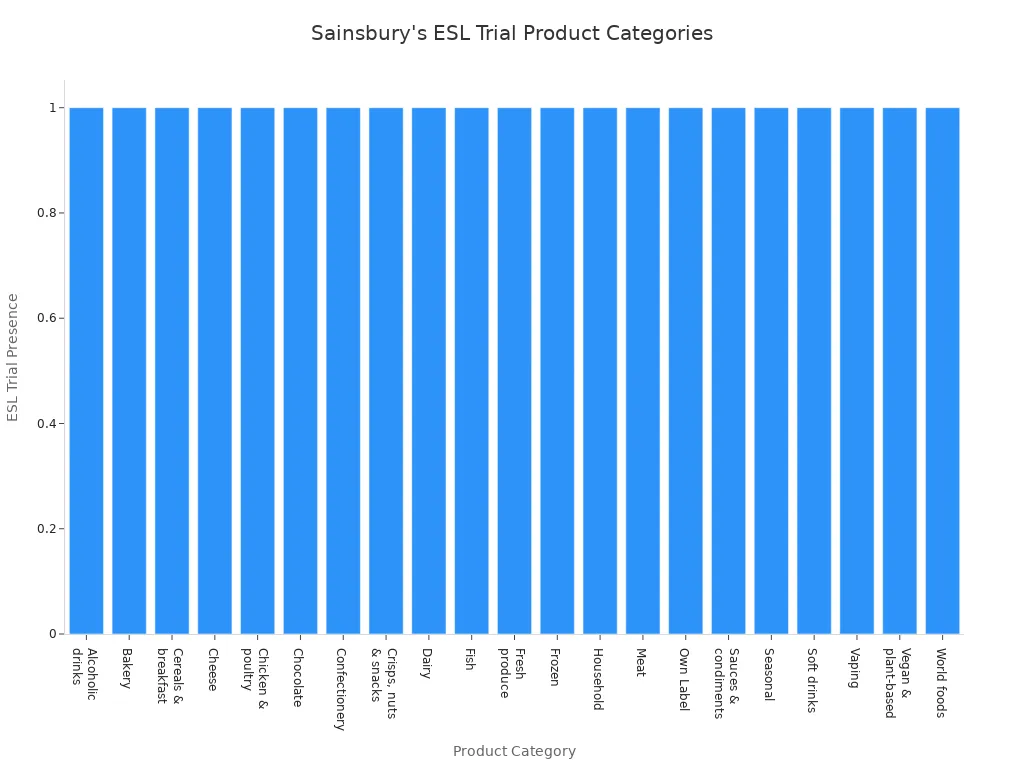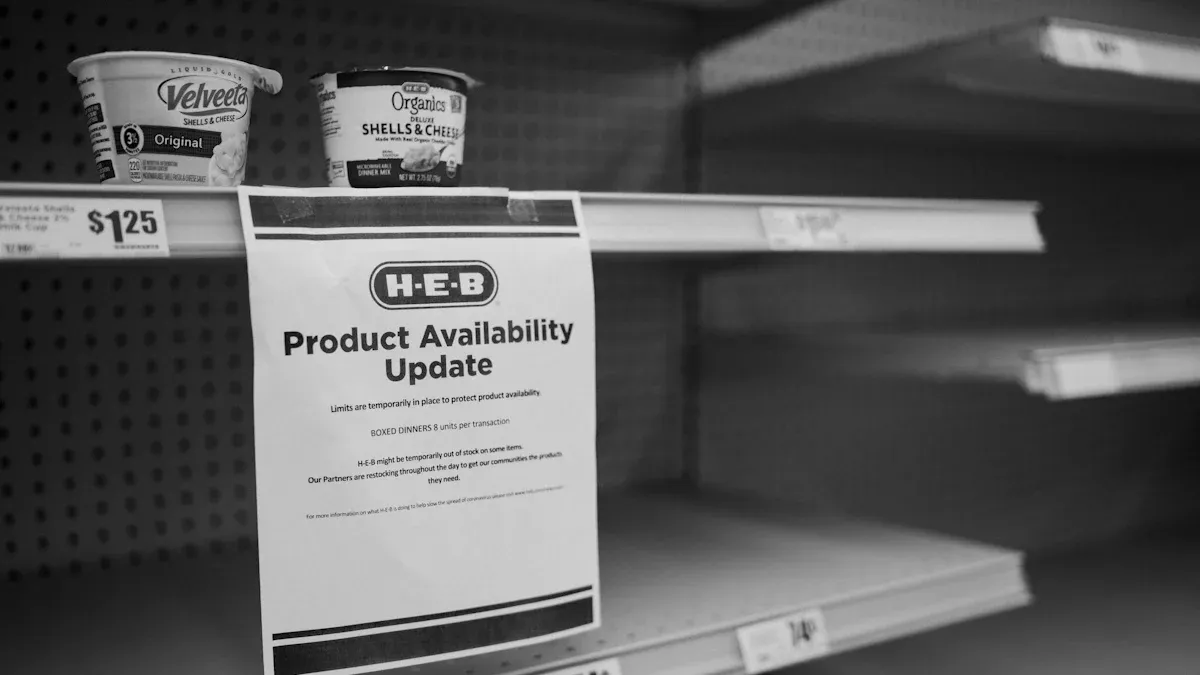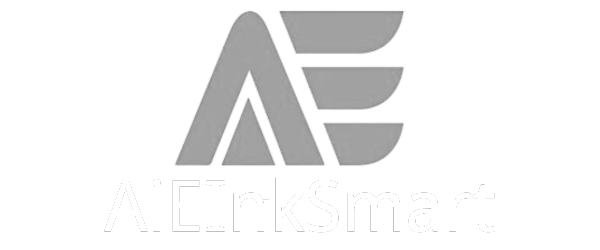
When you enter Sainsbury’s stores in 2025, you encounter sainsbury’s electronic shelf labels instead of traditional paper price tags. The new electronic labels use e-paper or LCD technology, updating prices through the ESL Gateway AP in real time. You notice that the ESL Price Tag quietly displays current prices, promotions, and stock alerts across product categories like alcohol, health, and general merchandise. Esl Retail technology enables dynamic pricing and instant updates, improving accuracy and reducing paper waste. Unlike paper tags, Electronic Shelf Labels silently change without visible stickers, which may affect how you spot deals.
Sainsbury’s Electronic Shelf Labels: What Shoppers Will See

Digital price tags replacing paper labels
When you walk through Sainsbury’s aisles in 2025, you notice a significant change in how product information appears on shelves. The classic paper price tags have given way to digital price tags, which use wireless technology to display prices and promotions. These electronic shelf-edge labels create a modern look, making the shelves appear cleaner and more organized. You see digital displays attached to the front edge of shelving, replacing the clutter of paper tags.
Tip: You can rely on the digital labels for the most current price and promotional information, as updates happen instantly and remotely.
The transition to Sainsbury’s electronic shelf labels means you experience a tech-forward environment. The labels update in real time, so you always see accurate prices. Sainsbury’s has started this transformation in select stores, including the Witney ‘Future Store’ in Oxfordshire and several larger-format locations. Most stores still use paper labels, but the digital rollout is expanding as trials continue. You may notice these changes first in categories like wine, beer, spirits, and health products, where dynamic pricing and frequent promotions are common.
- Shelves now feature digital wireless displays instead of paper tags.
- Prices and promotions update instantly, providing you with up-to-date information.
- The overall shelf-edge appearance looks more modern and dynamic.
Where electronic shelf-edge labels are used in Sainsbury’s stores
Sainsbury’s electronic shelf-edge labels appear in a growing number of stores, especially those participating in technology trials. You find these labels in the Witney ‘Future Store’ and three other larger-format stores. Sainsbury’s has not released exact figures, but most locations still rely on paper labels while the company evaluates the benefits of digital price tags.
You see electronic shelf-edge labels across a wide range of product categories. The technology is most visible in sections with frequent price changes and promotions. The following table shows where you are most likely to encounter these labels:
| Product Categories Featuring ESL Trials |
|---|
| Alcoholic drinks (beer, wine, spirits) |
| Bakery |
| Cereals & breakfast |
| Cheese |
| Chicken & poultry |
| Chocolate |
| Confectionery |
| Crisps, nuts & snacks |
| Dairy |
| Fish |
| Fresh produce |
| Frozen |
| Household |
| Meat |
| Own Label |
| Sauces & condiments |
| Seasonal |
| Soft drinks |
| Vaping |
| Vegan & plant-based |
| World foods |

You notice that Sainsbury’s electronic shelf labels cover everything from alcoholic drinks to vegan and plant-based products. The supermarket uses these labels to improve pricing accuracy and reduce labor costs. As Sainsbury’s continues to expand the use of electronic shelf-edge labels, you can expect to see them in more categories and stores over time.
How Sainsbury’s Electronic Shelf-Edge Labels Work

Real-time price and information updates
You experience a new level of accuracy when shopping at Sainsbury’s. The electronic shelf-edge labels display prices and product details that update instantly. Sainsbury’s uses a system from VusionGroup, which supports dynamic pricing. This technology allows you to see real-time price updates as soon as they are made in the store’s central system. You notice that prices for perishable items, such as fresh produce or dairy, can change throughout the day based on shelf life and availability. Computer vision technology monitors these products, helping Sainsbury’s reduce waste and improve stock levels.
Note: You always see the latest price and promotion on the shelf, which means fewer surprises at checkout.
The digital labels also show stock alerts and special offers. You do not need to search for paper tags or worry about outdated information. The system ensures that every label reflects the current status of the product, whether it’s a flash sale or a markdown for items nearing expiration.
Centralized control and wireless technology
You benefit from a streamlined shopping experience because Sainsbury’s manages all electronic shelf-edge labels from a central location. Store staff use wireless technology to send updates directly to the labels. This process eliminates manual changes and reduces human error. The labels connect to the store’s network, receiving instructions for price changes, promotions, and product information.
Here is how the process works:
- Sainsbury’s central system schedules price or information updates.
- Wireless signals transmit these changes to the digital labels on the shelves.
- The labels refresh automatically, showing the new details within seconds.
| Step | Action | Benefit to You |
|---|---|---|
| 1 | Central system updates price | Accurate shelf pricing |
| 2 | Wireless transmission | Fast, seamless changes |
| 3 | Label refreshes instantly | Reliable product info |
You see a more organized store, with fewer errors and less clutter. The digital system supports efficient management, allowing staff to focus on helping you rather than replacing paper tags.
Benefits of Sainsbury’s Electronic Shelf Labels for Shoppers
Accurate pricing and fewer errors
You expect accurate pricing every time you shop. Sainsbury’s electronic shelf labels deliver this by updating prices directly from a central system. This process removes the risk of human error that often occurs with manual paper label changes. When you pick up an item, you see the correct price displayed on the shelf, which matches the price at checkout. This consistency builds trust and reduces confusion.
Staff no longer spend hours replacing paper tags or double-checking for mistakes. Instead, the system updates all labels at once, ensuring every product displays the latest information. You avoid surprises at the till, and staff can focus on helping you rather than fixing errors. This approach improves your shopping experience and increases confidence in store pricing.
Instant updates for deals and promotions
You benefit from instant access to the latest deals and promotions. Sainsbury’s can update thousands of prices across the store in just minutes, compared to the days or even weeks required with traditional paper labels. The following table highlights the dramatic difference in update speed:
| Aspect | Traditional Paper Labels | Electronic Shelf-Edge Labels (ESLs) |
|---|---|---|
| Time to update 120,000 items | Approximately 2 days (manual labor) | A few minutes (automated simultaneous update) |
| Full-store repricing time | Up to 2 weeks | Less than 5 minutes |
| Labor hours spent weekly | Over 50 hours | Significantly reduced due to automation |
You see new offers and price drops as soon as they go live, without waiting for staff to change tags. During sales events, Sainsbury’s can adjust prices across all departments almost instantly. This flexibility means you never miss out on a promotion because of outdated shelf information. The system also allows Sainsbury’s to respond quickly to market changes, keeping your shopping experience fresh and competitive.
Tip: Always check the electronic shelf label for the latest deal—updates happen in real time, so you get the best price available.
Improved store efficiency and sustainability
You notice a more organized and efficient store environment. Sainsbury’s electronic shelf labels streamline operations by automating routine tasks. Staff spend less time on manual updates and more time assisting you on the shop floor. This shift leads to faster service and better support when you need help.
The transition to digital labels also helps avoid paper waste, supporting Sainsbury’s commitment to sustainability. By eliminating the need for thousands of paper tags each week, the supermarket achieves significant environmental benefits. The reduction in paper use, combined with lower labor demands, makes stores more efficient and eco-friendly.
You play a part in this positive change every time you shop. The move to electronic shelf labels not only improves your experience but also contributes to a greener future.
Shopping Experience Changes with Electronic Shelf Labels
Finding prices and special offers
You walk into Sainsbury’s and see digital shelf labels displaying clear, up-to-date prices. Locating the price of any item becomes straightforward. The digital displays show not only the current price but also highlight special offers and loyalty discounts. You no longer need to search for paper tags or worry about missing a promotion. The labels update instantly, so you always see the latest deals as you move through the aisles.
Tip: Check the digital shelf label for flash sales or markdowns. You get the most accurate information right at the shelf.
Addressing concerns about price accuracy and dynamic pricing
You may wonder if electronic shelf labels mean unpredictable price changes. Sainsbury’s uses this technology to improve pricing accuracy and transparency. The system updates prices remotely, reducing errors and ensuring consistency between shelf and checkout. Sainsbury’s applies dynamic pricing mainly to lower prices, not to increase them. The goal is to reduce waste and offer targeted promotions, such as loyalty discounts. You see reductions for items nearing expiration or special offers, but you do not experience sudden price hikes due to demand or external factors. Sainsbury’s communicates these changes clearly, so you feel confident that dynamic pricing works in your favor.
Environmental impact and ease of use
You support sustainability every time you shop with electronic shelf labels. Sainsbury’s reduces paper and ink usage, lowering the environmental impact compared to traditional labels. The digital labels automate price reductions, helping to cut food waste. ESLs use power only when prices change, so energy consumption stays low. The typical battery life reaches up to 12 years, which means fewer replacements and less waste. Major UK retailers, including Sainsbury’s, trial this technology as part of broader sustainability efforts. You benefit from improved pricing accuracy and a cleaner store environment, while staff spend less time on manual updates.
- ESLs reduce paper and ink waste.
- Automated price reductions help lower food waste.
- Power consumption remains minimal when prices stay static.
- Long battery life means less frequent label replacement.
Sainsbury’s Electronic Shelf Labels vs. Other Supermarkets
How Sainsbury’s compares to Tesco, Asda, and others
You see Sainsbury’s taking a measured approach to electronic shelf-edge labels. The supermarket currently runs trials in select stores, focusing on categories with frequent price changes. This pace differs from other retailers trialling electronic shelf-edge labels. Tesco halted its rollout in 2017, so you find fewer digital price tags there. Asda has conducted its largest trial but continues with smaller, targeted experiments rather than a full-scale launch. Co-op and Southern Co-op have moved faster, with Southern Co-op completing a large-scale rollout and Co-op planning full adoption by 2026. Aldi and Lidl have also started implementing electronic shelf-edge labels after successful pilots. Sainsbury’s adoption rate remains slower than Co-op and Southern Co-op, but you notice it is more progressive than Tesco and aligns closely with Asda’s cautious strategy.
| Supermarket | ESL Adoption Status | Rollout Approach |
|---|---|---|
| Sainsbury’s | Early trials, limited stores | Cautious, expanding |
| Tesco | Rollout halted in 2017 | Stalled |
| Asda | Ongoing trials, largest to date | Cautious, targeted |
| Co-op | Full adoption planned by 2026 | Aggressive, nationwide |
| Southern Co-op | Large-scale rollout completed | Advanced |
| Aldi/Lidl | Pilots completed, rollout started | Progressive |
Note: You experience more digital shelf labels in Co-op and Southern Co-op stores than in Sainsbury’s or Tesco.
Unique features of Sainsbury’s electronic shelf-edge labels
You discover several unique features when shopping at Sainsbury’s. The electronic shelf-edge labels form part of a broader digital ecosystem. You see digital screens in every aisle and shelf technology that monitors stock levels. Sainsbury’s uses shelf-edge banners to categorize products, such as Gut Health Support or Immune Support for yogurts. This organization helps you navigate the store efficiently and mirrors online shopping filters, narrowing choices and reducing overwhelm.
- Sainsbury’s integrates electronic shelf-edge labels with digital screens and stock monitoring.
- Shelf-edge banners group products into segments, making it easier for you to find what you need.
- The system supports dynamic pricing and enhanced product information, improving your shopping experience.
These features create a more interactive and informative environment compared to other supermarkets. You benefit from a future-focused store concept that combines technology and convenience. While other retailers trialling electronic shelf-edge labels may offer basic digital price tags, Sainsbury’s aims to deliver a comprehensive digital network for shoppers.
You can expect Sainsbury’s electronic shelf labels to deliver accurate prices, real-time promotions, and clear product details in 2025. These digital labels streamline your shopping by reducing errors and supporting sustainability.
- You benefit from dynamic pricing, consistent information, and improved staff service.
- The technology supports omnichannel integration, making your in-store and online experiences seamless.
Sainsbury’s continues to trial and expand these innovations, shaping a future where your shopping becomes more efficient, transparent, and environmentally friendly.
FAQ
How do you know the price on the electronic shelf label is correct?
You see the price update instantly from Sainsbury’s central system. The label always matches the checkout price. You avoid confusion and trust the displayed price.
Can you still find special offers and discounts with electronic shelf labels?
You spot promotions and discounts directly on the digital label.
- Flash sales
- Loyalty offers
- Price reductions
Check the label for the latest deal before you buy.
What happens if the electronic shelf label stops working?
You alert a staff member if you notice a blank or malfunctioning label. Sainsbury’s team resolves issues quickly. You receive accurate pricing at checkout, even if the label fails.
Do electronic shelf labels affect your shopping speed?
You shop faster because you find prices and offers easily. The digital labels display clear information, so you spend less time searching for deals or asking staff.
Are electronic shelf labels environmentally friendly?
You support sustainability by shopping with electronic shelf labels. Sainsbury’s reduces paper waste and energy use. The labels last for years, minimizing environmental impact.


